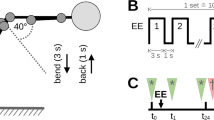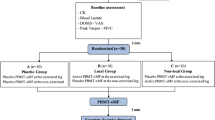Abstract
The present pilot study investigated the analgesic efficacy of light-emitting diode (LED). In view of a standardised and controlled pain reduction study design, this in vivo trial was conducted on experimentally induced delayed-onset muscle soreness (DOMS). Thirty-two eligible human volunteers were randomly assigned to either an experimental (n=16) or placebo group (n=16). Immediately following the induction of muscle soreness, perceived pain was measured by means of a visual analog scale (VAS), followed by a more objective mechanical pain threshold (MPT) measurement and finally an eccentric/concentric isokinetic peak torque (IPT) assessment. The experimental group was treated with infrared LED at one of both arms, the other arm served as control. Irradiation lasted 6 min at a continuous power output of 160 mW, resulting in an energy density of 3.2 J/cm2. The subjects of the placebo group received sham irradiation at both sides. In post-treatment, a second daily assessment of MPT and VAS took place. The treatment and assessment procedure (MPT, VAS and IPT) was performed during 4 consecutive days. Statistical analysis (a general linear model followed by post hoc least significant difference) revealed no apparent significant analgesic effects of LED at the above-described light parameters and treatment procedure for none of the three outcome measures. However, as the means of all VAS and MPT variables disclose a general analgesic effect of LED irradiation in favour of the experimental group, precaution should be taken in view of any clinical decision on LED. Future research should therefore focus on the investigation of the mechanisms of LED action and on the exploration of the analgesic effects of LED in a larger randomised clinical trial and eventually in more clinical settings.



Similar content being viewed by others
References
Vinck E, Coorevits P, Cagnie B, Muynck MD, Vanderstraeten G, Cambier D (2005) Evidence of changes in sural nerve conduction mediated by light emitting diode irradiation. Lasers Med Sci. DOI 10.1007/s10103-005-0333-2
Cheung K, Hume PA, Maxwell L (2003) Delayed onset muscle soreness—treatment strategies and performance factors. Sports Med 33(2):145–164
MacIntyre DL, Reid WD, McKenzie DC (1995) Delayed muscle soreness. The inflammatory response to muscle injury and its clinical implications. Sports Med 20(1):24–40
Minder PM, Noble JG, Alves-Guerreiro J, Hill ID, Lowe AS, Walsh DM et al (2002) Interferential therapy: lack of effect upon experimentally induced delayed onset muscle soreness. Clin Physiol Funct Imaging 22(5):339–347
Clarkson PM, Tremblay I (1988) Exercise-induced muscle damage, repair, and adaptation in humans. J Appl Physiol 65(1):1–6
Cleak MJ, Eston RG (1992) Delayed onset muscle soreness: mechanisms and management. J Sports Sci 10(4):325–341
Craig JA, Cunningham MB, Walsh DM, Baxter GD, Allen JM (1996) Lack of effect of transcutaneous electrical nerve stimulation upon experimentally induced delayed onset muscle soreness in humans. Pain 67(2–3):285–289
Craig JA, Barron J, Walsh DM, Baxter GD (1999) Lack of effect of combined low intensity laser therapy/phototherapy (CLILT) on delayed onset muscle soreness in humans. Lasers Surg Med 24(3):223–230
Ebbeling CB, Clarkson PM (1989) Exercise-induced muscle damage and adaptation. Sports Med 7(4):207–234
Tiidus PM, Ianuzzo CD (1983) Effects of intensity and duration of muscular exercise on delayed soreness and serum enzyme-activities. Med Sci Sports Exerc 15(6):461–465
Glasgow PD, Hill ID, McKevitt AM, Lowe AS, Baxter D (2001) Low intensity monochromatic infrared therapy: a preliminary study of the effects of a novel treatment unit upon experimental muscle soreness. Lasers Surg Med 28(1):33–39
Armstrong RB (1984) Mechanisms of exercise-induced delayed onset muscular soreness: a brief review. Med Sci Sports Exerc 16(6):529–538
Rodenburg JB, Steenbeek D, Schiereck P, Bar PR (1994) Warm-up, stretching and massage diminish harmful effects of eccentric exercise. Int J Sports Med 15(7):414–419
Ciccone CD, Leggin BG, Callamaro JJ (1991) Effects of ultrasound and trolamine salicylate phonophoresis on delayed-onset muscle soreness. Phys Ther 71(9):666–675; discussion 675–678
Craig J, Barlas P, Baxter D, Walsh D, Allen J (1996) Delayed-onset muscle soreness: lack of effect of combined phototherapy/low-intensity laser therapy at low pulse repetition rates. J Clin Laser Med Sur 14(6):375–380
Ernst E (1998) Does post-exercise massage treatment reduce delayed onset muscle soreness? A systematic review. Br J Sports Med 32(3):212–214
Dvir Z (2003) Isokinetics: muscle testing, interpretation and clinical applications. Churchill Livingstone, Edinburgh
Lambert MI, Marcus P, Burgess T, Noakes TD (2002) Electro-membrane microcurrent therapy reduces signs and symptoms of muscle damage. Med Sci Sports Exerc 34(4):602–607
Sumida K, Greenberg M, Hill J (2003) Hot gel packs and reduction of delayed-onset muscle soreness 30 minutes after treatment. J Sport Rehabil 12:221–228
Tiidus PM, Shoemaker JK (1995) Effleurage massage, muscle blood flow and long-term post-exercise strength recovery. Int J Sports Med 16(7):478–483
Zhang J, Clement D, Taunton J (2000) The efficacy of Farabloc, an electromagnetic shield, in attenuating delayed-onset muscle soreness. Clin J Sport Med 10(1):15–21
Fitzgerald GK, Rothstein JM, Mayhew TP, Lamb RL (1991) Exercise-induced muscle soreness after concentric and eccentric isokinetic contractions. Phys Ther 71(7):505–513
Nosaka K, Clarkson PM (1997) Influence of previous concentric exercise on eccentric exercise-induced muscle damage. J Sports Sci 15(5):477–483
Jensen MP, Karoly P, Braver S (1986) The measurement of clinical pain intensity—a comparison of 6 methods. Pain 27(1):117–126
Price DD, Mcgrath PA, Rafii A, Buckingham B (1983) The validation of visual analog scales as ratio scale measures for chronic and experimental pain. Pain 17(1):45–56
Revill SI, Robinson JO, Rosen M, Hogg MIJ (1976) Reliability of a linear analog for evaluating pain. Anaesthesia 31(9):1191–1198
Nussbaum EL, Downes L (1998) Reliability of clinical pressure–pain algometric measurements obtained on consecutive days. Phys Ther 78(2):160–169
Lowe AS, Baxter GD, Walsh DM, Allen JM (1994) Effect of low intensity laser (830 nm) irradiation on skin temperature and antidromic conduction latencies in the human median nerve: relevance of radiant exposure. Lasers Surg Med 14(1):40–46
Noble J, Lowe A, Baxter G (2001) Monochromatic infrared irradiation (890 nm): effect of a multisource array upon conduction in the human median nerve. J Clin Laser Med Sur 19(6):291–295
Pontinen PJ, Aaltokallio T, Kolari PJ (1996) Comparative effects of exposure to different light sources (He–Ne laser, InGaAl diode laser, a specific type of noncoherent LED) on skin blood flow for the head. Acupunct Electro-Ther Res 21(2):105–118
Vinck E, Cagnie B, Cambier D, Cornelissen M (2001) Does infrared light emitting diodes have a stimulatory effect on wound healing? From an in vitro trial to a patient treatment. Progr Biomed Opt Imaging 3(28 Proceedings of SPIE 4903):156–165
Vinck EM, Cagnie BJ, Cornelissen MJ, Declercq HA, Cambier DC (2003). Increased fibroblast proliferation induced by light emitting diode and low power laser irradiation. Lasers Med Sci 18(2):95–99
Vinck EM, Cagnie BJ, Cornelissen MJ, Declercq HA, Cambier DC (2005) Green light emitting diode irradiation enhances fibroblast growth impaired by high glucose level. J Photomed Laser Surg 23(2):167–171
Pollo A, Amanzio M, Arslanian A, Casadio C, Maggi G, Benedetti F (2001) Response expectancies in placebo analgesia and their clinical relevance. Pain 93(1):77–84
Shellock FG, Prentice WE (1985) Warming-up and stretching for improved physical performance and prevention of sports-related injuries. Sports Med 2(4):267–278
Safran MR, Seaber AV, Garrett WE (1989) Warm-up and muscular injury prevention an update. Sports Med 8(4):239–249
Schindl A, Heinze G, Schindl M, Pernerstorfer Schon H, Schindl L (2002) Systemic effects of low-intensity laser irradiation on skin microcirculation in patients with diabetic microangiopathy. Microvasc Res 64(2):240–246
Rochkind S, Rousso M, Nissan M, Villarreal M, Barr Nea L, Rees DG (1989) Systemic effects of low-power laser irradiation on the peripheral and central nervous system, cutaneous wounds, and burns. Lasers Surg Med 9(2):174–182
Acknowledgements
The authors would like to thank Mr. T. Barbe and Mr. R. Deridder for their technical assistance in the collection of the data, as well as for their valuable input into the research design. Sincere appreciation is extended to the volunteers that participated in this study and to MDB-Laser (Belgium) for generously providing the light-emitting diode equipment. The authors also gratefully recognize Prof. Dr. G. Van Maele for assistance with the statistical analysis and for helpful discussion.
Author information
Authors and Affiliations
Corresponding author
Rights and permissions
About this article
Cite this article
Vinck, E., Cagnie, B., Coorevits, P. et al. Pain reduction by infrared light-emitting diode irradiation: a pilot study on experimentally induced delayed-onset muscle soreness in humans. Lasers Med Sci 21, 11–18 (2006). https://doi.org/10.1007/s10103-005-0366-6
Received:
Accepted:
Published:
Issue Date:
DOI: https://doi.org/10.1007/s10103-005-0366-6




